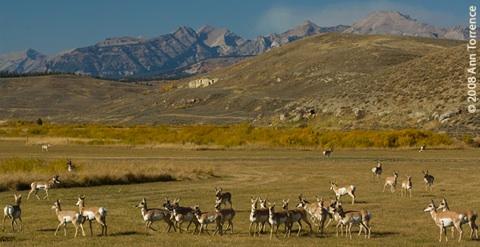As the weather cools and available daylight decreases, many wild animals become restless. They know winter is on the way and they could face months of freezing temperatures and food shortages.
All animals prepare for and deal with the winter season in their own way. For example, groundhogs and bears attempt to survive by waiting it out. They make stockpiles of food so they can live of off fat reserves during hibernation. In comparison, bird species and a few mammals and butterflies take a much different approach to winter. They stave off hunger by making journeys to wherever the food is most available. Depending on the species, these migrations range from short to just short of epic. While mule deer move just a few miles down a mountain, barn swallows migrate thousands of miles each year between the summer breeding grounds in North America to winter in Central and South America.
This autumn, take some time to visit one of the country’s national parks to see the migration. You could be rewarded with a rare bird sighting or an amazing photograph opportunity. No matter what happens, you will be in for a treat.
Here are a few of the many autumn animal migrations you can witness and watch for in our nation’s national parks:
Pronghorn Antelope – The Grand Teton National Park is one of the most majestic parks in the United States. Visitors are greeted with stunning views and fantastic camping, hiking, and cross-country skiing. Autumn is a great time in the Tetons because the leaves are changing color, elk are breeding (going through the rut), and the pronghorns are starting their migration south.
Pronghorns spend their summers in the park, eating and raising their calves. In early fall, small herds totaling about 200 pronghorns, begin the long, treacherous journey to their winter feeding grounds near Pinedale, Wyoming. When the herds reach Pinedale, they will have traveled about 150 miles. Grand Teton pronghorns have the longest land migration in the continental United States (only caribou have a longer migration in North America). Although they start out in a national park, their journey has them migrating on private land, under fences, and across roads. It is a hard journey that is getting more and more difficult as human construction and development in Wyoming increases.
Raptors – Whereas songbirds steal the show in spring, autumn is the season for watching migrating raptors. Raptors such as broad-winged hawks, ospreys, and Swainson’s hawks make long migrations to wintering grounds in the southern U.S., Central and South America. They glide along warm thermal winds during the day, allowing them to be easily noticeable even to amateur bird watchers. Although you can watch for migrating raptors throughout the U.S., some of the best spots occur along the eastern seaboard.
In the autumn months, it would be a challenge not to see a migrating raptor in the national parks of the East. One of the largest regional parks, Virginia’s Shenandoah National Park, offers great views of broad-winged hawks. National park visitors traveling from the urban centers of Washington, D.C., and New York can see migrating ospreys, merlins, and kestrels in Gateway National Recreation Area and Assateague Island National Seashore.
It might seems strange to associate the Florida Keys with raptors, but many raptors use the Keys as a temporary layover before they fly to the Caribbean or across the Gulf of Mexico. At Dry Tortugas National Park you can see peregrine falcons and sharp-shinned hawks, among others.
Butterflies – Not all monarch butterflies head to Mexico to survive the winter. Monarchs that travel on the Pacific Flyway, a large migratory corridor along the Pacific Coast, spend their winters on the southern California coast. According to the Xerces Society for Invertebrate Conservation, more than one million monarchs migrate to California each autumn.
Two good places to watch for migrating monarch butterflies are Muir Woods National Monument and Los Padres National Forest. Muir Woods, just north of San Francisco, is one of the more northern parks with migratory monarchs. Many of the monarchs are just passing through on their way to Santa Cruz and San Luis Obispo, but a few manage to stay all winter. At Los Padres National Forest, the monarch butterflies stay throughout the autumn and winter only to depart again in spring.
Help the Xerces Society protect Pacific flyway monarchs by reporting butterfly sightings online - http://www.xerces.org/california-monarchs/
Waterfowl – Large numbers of migratory waterfowl use the Central and Mississippi flyways to get to their wintering grounds in the southern United States and Gulf Coast. A diversity of species can be seen throughout Texas, Louisiana, Arkansas, and Mississippi. The best places to look for waterfowl are wetlands, such as marshes, ponds and seasonal pools.
Blue-winged teals and northern shovelers make layovers at the Buffalo National River in Arkansas on their way to the coast. Visitors to Jean Lafitte National Historical Park and Preserve in Louisiana will also get to see blue-winged teals, along with mallards and lesser scaups. Even though Texas is usually the last stop for many migratory birds, you might see redheads passing through Big Thicket National Preserve.
If you get a chance to spot a migratory animal in a national park or passing through your backyard, report your sighting to the National Wildlife Federation’s Wildlife Watch. As an online resource for learning about diverse animal and plant species, the Wildlife Watch website allows you to share your wildlife sightings, photos, and stories with others. Get started today at www.nwf.org/wildlifewatch
Wildlife Watch is part of NWF’s Be Out There campaign that inspires caregivers to spend daily time outdoors with the children in their lives. Families who go outside together raise healthier and happier kids who become better stewards of the environment. Visit www.nwf.org/beoutthere for more information.




Add comment